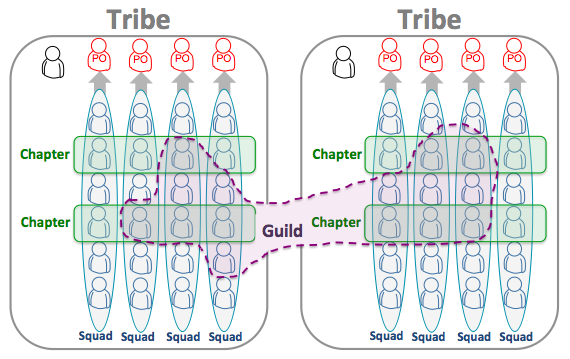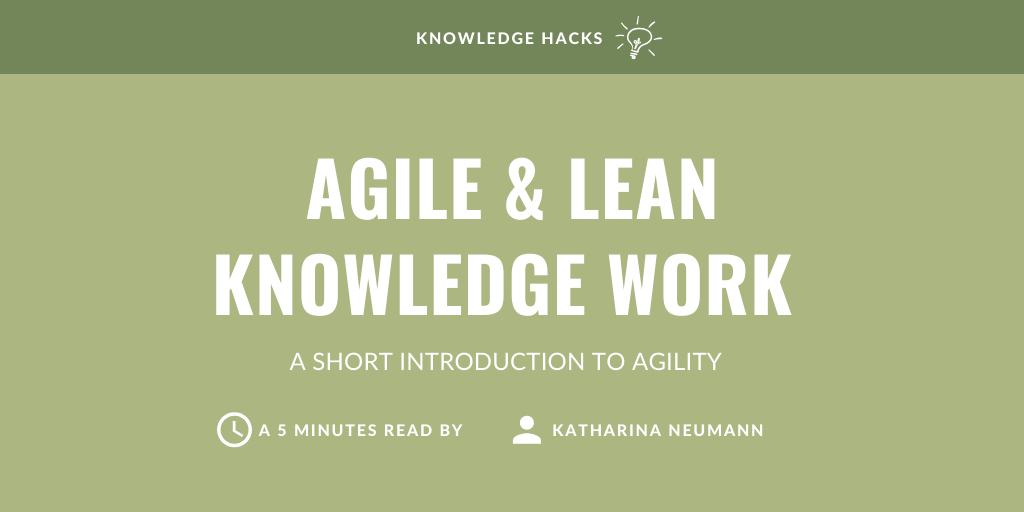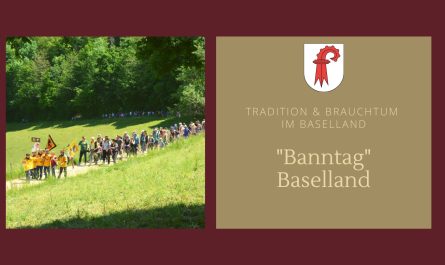Agile? Lean? Kanban? Scrum? Wasn’t that something for software developers only? Don’t worry, within this short introductory guide, I will provide you within an overview of the most important terms and methods. Agile methods, namely scrum, kanban and lean development take their origins within most company’s IT departments and software development teams but can also be applied to projects in other departments. Furthermore agility can play an important role within leadership and change management, but more on that later!
Are you ready to become agile?
The Agile Manifesto for Software Development
Iterative development of product and services has a long history and can be traced back as early as the 1960s. In the 1990s, software developers became more and frustrated with their overly regulated and micro-managed methods as communication between business managers and developers has been complicated and product development times prolonged significantly. Why not simplify processes? With methods such as Scrum replacing existing Waterfall models, software developers speeded up the process. Almost 20 years ago, 17 software developers gave a framework to these changes: The Manifesto for Agile Software Development which comprises 12 principles such as highest priority is given to the satisfaction of customer needs or building a supporting environment for motivated individuals.

The agile manifesto is supported by four foundational values (Rigby et al., 2016):
- People over processes and tools: build projects around motivated people
- Respond to change rather than follow a plan: only plan tasks that are unlikely to change
- Working protypes over excessive documentation: experiment, fail, adapt, try again
- Customer collaboration over rigid contracts: engage customers throughout the process
As you can see from the visualization, agility is very much about working together in small teams, embracing change, sharing knowledge and creating a knowledge-friendly and innovative culture. But what do these key-term actually mean? Let me present you with a short wiki of the most important terms related to agile organizations.
The Agile Wiki – Part 1
The following section will give you short definitions with some important agile terms. Please click the little arrow next to the term to discover its definition.
Agility
Agility refers to the ability of an organization to react in a flexible manner to changes in the market environment and is the opposite to decision making through slow, bureaucratic and fully formalized processes.
Ambidextry
Ambidextry refers to the ability of organizations to be both efficient and flexible. It emphasizes the importance of integrating exploitation (exploiting what exists) and exploration (exploring what is new) in an organization.
Backlog
A backlog is basically a collection of open tasks, ideas and is never complete as it grows and changes within the different sprints (Scrum Method). The Product Owner prioritizes the different items within the backlog based on their importance.
Business Model Canvas
Business Model Canvas (BMC) is an agile method to quickly set up business plans and make them adaptable to market changes. The BMC visually divides business models into their 9 most important elements.
Cross-functional teams
Cross-functional teams are teams of experts with members from different, complementary disciplines. Agile teams are usually cross-functional.
Daily stand-up
A Daily Standup is meeting format from the Scrum method. The team comes together daily for a meeting of max. 15 minutes and exchanges information about their work and current challenges.
Design Thinking
Design Thinking is an approach to promote innovative and creative new ideas and problem solving. In doing so, it focuses on the needs of the end user (user perspective). With the help of iterative processes one approaches a user-oriented solution.
Empathy Map
An empathy map, summarizes and structures knowledge about customer needs.
Holocracy
Holocracy is a systemic approach which gives a structure to decision-making by giving employees at all levels opportunities for participation.
Iteration
Iteration generally describes a process of repeating the same or similar actions several times to approach a solution or a specific goal. Working iteratively means taking many small steps and reflecting on them quickly in order to learn from them for the next step.
Kaizen
Kaizen is a procedure from Japanese manufacturing technology and means consistent innovation management or simply improvement. The Kaizen philosophy stands for improvement by everyone, always and everywhere.
Kanban
Is this about the post its? Yes! The kanban method is used to make tasks within a team visible for everyone. It limits the number of processes running in parallel and enables better planning of projects and resources. An integral part is the kanban board, where tasks are grouped in columns according to their status (e.g. Not started, Work in Progress, Done).
Lean Management
The main objective of Lean Management is to coordinate all processes and activities in such a way that any kind of waste along the value chain is avoided.
New Work
New Work is an approach to organising people and their work places in dynamic markets, where self-determination, creativity and flexible working play a major role.
Product Owner
The Product Owner represents the customer perspective within the team and is responsible for maximizing the value of the product through the work of the development team.
Scrum
Scrum is an agile framework for dynamic project development that allows teams to react flexibly to changes in the project cycle. Planning and execution of tasks are carried out in fixed cycles (“sprints”).
Sprints
Sprints are the one to four week work cycles in the Scrum context. The duration of the sprint should be rhythmic and consistent.
VUCA
VUCA is an acronym and stands for Volatility, Uncertainty, Complexity, Ambiguity. The term is mainly used to describe a constantly changing market environment that companies face.
Spotify – the example of an agile business model
Organizations that think and work in an agile manner are characterized by self-organizing teams. One of the most prominent examples of an agile company is the online music streaming platform Spotify. Since 2006, the platform registers 140 million monthly active users and offers more than 30 million different titles. Spotify is organized by squads, tribes, chapters and guilds (van der Wardt, 2020).

- A Squad is the basis of the Spotify agile model and comparable to a normal scrum team. Within multidisciplinary teams which act as little start-up different features of the platform are developed. However each squad follows a defined long-term vision i.e. development and improvement of the music streaming platform.
- A Tribe is a group of squads that work on the same product or service related to the platform. This enables Spotify to generate innovative ideas and exchange knowledge on existing product development features.
- A chapter consists of members of a tribe who have the same expertise, e.g. software developers. Again, employees within the chapter use the opportunity to exchange knowledge and experiences. Furthermore they update each other on potential challenges on their topic of expertise in order to get assistance of other experts.
- A guild is a group of employees with the same expertise and/or the same interests Guilds are not limited to one tribe, but involve the entire organization.
Agile as a Mindset
Agility is not only a topic for software developers but also plays an important role in leadership. Did you grow up knowing exactly what to do in your later career? What is your 5 to 10 years masterplan? Within her TEDxTalk Emily Phillips explains how agility helps you to face life’s challenges and unlock success within your career. If you want to know more, watch her humorous talk on her personal story with agile leadership! #highlyrecommended
https://www.youtube.com/watch?v=NWMS5wDSPs8
If you want to know more about the tools used within agile companies stay tuned for next week’s Knowledge Wednesday!
Missed a blog post? Readers who have read this article have also read …
- Why a 400 year old idea will take you on a modern knowledge journey
- About pyramids and snow – the difference between data, information and knowledge
- What is knowledge management and why is it important?
- About lunch with CEOs and other knowledge management techniques
- WOL, BI & Co – Four knowledge trends you need to know about
- How much knowledge is too much? About Covid-19, The Circle and Data Privacy
- From Alpha to Z: Inter- and Intragenerational Knowledge Management
Bibliography
Böhm, J. (2019). Erfolgsfaktor Agilität. Warum Scrum und Kanban zu zufriedenen Mitarbeitern und erfolgreichen Kunden führen (E-Book). Wiesbaden: Springer Vieweg.
Eby, K. (2016). Comprehensive Guide to the Agile Manifesto. Retrieved 24 April 2020, from https://www.smartsheet.com/comprehensive-guide-values-principles-agile-manifesto
Hochschule Luzern. Controlling Wiki. (2020). Agile Methoden – Controlling-Wiki. Retrieved 24 April 2020, from https://wiki.hslu.ch/controlling/Agile_Methoden
Me Company. (2020). Agile Wiki: Agile Arbeit kompakt erklärt – Me & Company. Retrieved 24 April 2020, from https://www.me-company.de/magazin/agile-wiki/
Rigby, D. K., Sutherland, J., & Takeuchi, H. (2016). Embracing agile. Harvard Business Review, 94(5), 40-50
van der Wardt, R. (2020). Das Spotify Modell: Agile und Scrum für große Organisationen. Retrieved 24 April 2020, from https://agilescrumgroup.de/spotify-modell/




Hi Katharina
Thank you again for this intresting Blog. These agile methods are really intresting and i like them. Unfortenatly, the problem is often that people are not willing to adapt these agile methods, they like the old way of working and think this doesent help.
Best
Sandro
Hi Sandro, glad you liked to short introduction to this topic and also thanks for sharing your insights. Indeed agility might not be the cure for all business problems and might not work within all settings but I believe it should work like a toolbox – just select the tools you need to fix the problem. Looking forward to welcoming you back on the blog soon! 🙂
Hello Katharina,
Very good introduction into the topic of agility. I loved the little Wiki, so practical and insightful!
I think it’s also nice to read such a good article since agile technics are discussed a lot but there are a lot of bull***t written on the topic too. This one goes straight to the point!
I’m looking forward to reading about the use of the tools within companies next week.
See you then,
Hi Juliette, thanks for your positive feedback, for the Wiki there will also be a second part in the next blogpost so stayed tuned! 🙂
Hi Katharina, I really like this comprehensive introduction to the world of agility.
I think I’ll implement some of the tips shared in the TEDx talk…maybe I’ll clear my mind a little bit about future decisions 🙂
Hi Margherita – thanks a lot for your comment- I think it’s always a good idea to think about future desicions – but don’t overthink 🙂
Thanks for that comprehensive introduction to agility. I really enjoyed the little wiki where I could only read about that terms that interested me the most. Cool feature!
Thanks for your feedback, Jens! Glad you enjoyed reading it. Stay tuned for the next post!